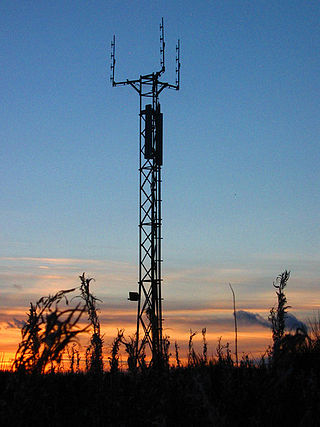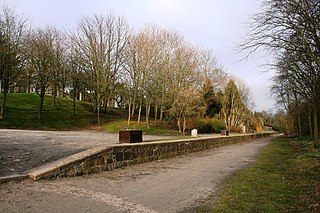
The River Dee is a river in Aberdeenshire, Scotland. It rises in the Cairngorms and flows through southern Aberdeenshire to reach the North Sea at Aberdeen. The area it passes through is known as Deeside, or Royal Deeside in the region between Braemar and Banchory because Queen Victoria came for a visit there in 1848 and greatly enjoyed herself. She and her husband, Prince Albert, built Balmoral Castle there which replaced an older castle.

Cults is a suburb on the western edge of Aberdeen, Scotland. It lies on the banks of the River Dee and marks the eastern boundary of Royal Deeside.

Westhill is a suburban town in Aberdeenshire, Scotland, located 7 miles (11 km) west of the city of Aberdeen.

Peterculter, also known as Culter, is a suburb of Aberdeen, Scotland, about eight miles (13 km) inland from Aberdeen city centre. Peterculter is on the northern banks of the River Dee, near the confluences with Crynoch Burn and Leuchar Burn. Following the 1996 Scottish council boundary changes it became part of the City of Aberdeen's Lower Deeside ward.
The Camphill Movement is an initiative for social change based on the principles of anthroposophy. Camphill communities are residential communities and schools that provide support for the education, employment, and daily lives of adults and children with developmental disabilities, mental health problems, or other special needs.
Milltimber is a suburb of Aberdeen, Scotland, around 6 miles (10 km) west of Aberdeen city centre. From 1854 to 1937 the area was served by Milltimber railway station on the Aberdeen suburban railway.
The city of Aberdeen, Scotland, contains a number of areas and suburbs, some of which are historically separate settlements that have been absorbed by the expanding city.

The Scottish city of Aberdeen has a number of green spaces and walkways. The parks, gardens and floral displays which include 2 million roses, 11 million daffodils and 3 million crocuses have led the city to win the Royal Horticultural Society's Britain in Bloom Best City award many times, including a period of nine years straight. It won the 2006 Scotland in Bloom Best City award along with the International Cities in Bloom award. The suburb of Dyce also won the Small Towns award.
Lower Deeside is a region along the River Dee in Aberdeenshire and Aberdeen in Scotland. The boundaries of this area are subject to interpretation, since the usage has altered through historic times; however, the area is generally associated with the communities of Durris, Maryculter and Banchory-Devenick in the historic district of Kincardineshire and the communities of Peterculter, Milltimber, Bieldside and Cults in Aberdeen.

Culter railway station was opened on 8 September 1853 by the Deeside Railway and served the town of Peterculter that is locally known as Culter. The Deeside Railway was taken over by the GNoSR and in 1894 Culter was the terminus for the Aberdeen suburban service although a few trains continued to Banchory. Despite the 1937 closure of many other stations on the Aberdeen suburban service, Culter remained open until 1966 as an intermediate station on the Deeside Railway that ran from Aberdeen (Joint) to Ballater. Culter is located in the parish of Peterculter, Aberdeenshire, Scotland.

Holburn Street railway station was a railway station in Aberdeen, Scotland. It was opened in July 1894 by the GNSR and served a suburb of Aberdeen near Duthie Park and Allenvale Cemetery. The station was one of several victims of the 1937 closure of stations on the Aberdeen suburban service. The Deeside Railway itself eventually ran from Aberdeen (Joint) to Ballater.

Milltimber railway station served the Milltimber area within the parish of Peterculter from 1854 to 1937 on the Deeside Railway that ran from Aberdeen (Joint) to Ballater. This area at that time had a number of mansion houses, estates, etc. such as Culter House, Fairgirth House, Camphill House, Avondow House, Glasterberry House, etc. whose workers, etc. would have used the station. Milltimber was only a short distance from Murtle station. The station was named for the nearby Milltimber Farm.

Bieldside railway station served the Bieldside area within the parish of Peterculter from 1897 to 1937 on the Deeside Railway that ran from Aberdeen (Joint) to Ballater. This area was the location of a number of mansion houses and estates such as Woodthorpe, Dalmunzie, The Firs, etc., some built as a result of the railway.

West Cults railway station served the small suburban village of West Cults area within the parish of Peterculter from 1894 to 1937 on the Deeside Railway that ran from Aberdeen (Joint) to Ballater. It lay very close to Cults and Bieldside.

Pitfodels railway station or Pitfodels Halt was opened on 2 July 1894 by the GNoSR and served a suburb of Aberdeen with housing and estates such as Wellwood, Inchgarth and Norwood. The halt was one of several victims of the 1937 closure of stations on the Aberdeen suburban service. The Deeside Railway itself ran from Aberdeen (Joint) to Ballater. Pitfodels is located in the parish of Peterculter, Aberdeenshire, Scotland.

Ruthrieston railway station or Ruthrieston Halt was opened in January 1856 by the GNSR and served Ruthrieston, now a suburb of Aberdeen. The halt was one of several victims of the 1937 closure of stations on the Aberdeen suburban service. The Deeside Railway itself eventually ran from Aberdeen (Joint) to Ballater. Ruthrieston is located in the parish of Peterculter, Aberdeenshire, Scotland.
Drum railway station was opened in January 1854 by the Deeside Railway and served the rural area around Drum Castle estate. The Deeside Railway was taken over by the GNoSR and in 1894 nearby Culter became the terminus for the majority of Aberdeen suburban services with only a few trains continuing through Drum to Banchory. Despite the 1937 closure of many other stations on the Aberdeen suburban service, Drum remained open until 1951 as an intermediate station on the Deeside Railway that ran from Aberdeen (Joint) to Ballater. Drum station was located in Drumoak Parish, Aberdeenshire, Scotland.

Park railway station was opened in September 1853 by the Deeside Railway and served the rural area around the Park estate, Nether Sunnyside, West Redford and the hamlet of Park. The Deeside Railway was taken over by the GNoSR and in 1894 nearby Culter became the terminus for the majority of Aberdeen suburban services with only a few trains continuing through Park to Banchory. Despite the 1937 closure of many other stations on the Aberdeen suburban service, Park remained open until 1966 as an intermediate station on the Deeside Railway that ran from Aberdeen (Joint) to Ballater. Park station was located in Drumoak Parish, Aberdeenshire, Scotland.















